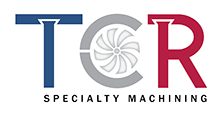What’s the difference between a mill and a lathe? It’s either the beginning of a machining joke or one of the most common questions asked in our industry. The following blog will not only answer the question, but will share how our Houston machine shop uses these two pieces of equipment to machine quality parts.
What Is A Mill?
Mills rotate a cylindrical cutting tool such as a drill, an end mill, a face mill, or a reamer to create holes, slots and a variety of other shapes within a 3 dimensional coordinate plane.
Some mills can machine parts in 4, 5, & 6 axis coordinate planes through the use of a rotating table, an extendable quill, or a 4th axis attachment with a chuck. Used on various prototypes and short-runs of complex parts, a mill is a must have for any machine shop.
What Is A Lathe?
A lathe is the opposite of a mill. It rotates the part against a stationary cutting tool that can be adjusted linearly to shape the part as it spins.
A lathe is used for turning, reaming, drilling, boring, knurling, producing screw threads and radius forming. It can range in size from a lightweight table top lathe to a gap lathe capable of machining long workpieces between centers.
What’s At Our Houston Machine Shop?
We have a variety of 3, 4, 5, & 6 axis mills capable of drilling, milling, and surfacing parts as big as 98”x78”x59”.
We also have several vertical and horizontal lathes capable of turning up to 78” in diameter x 60” tall and 27” diameter x 79” long.
At TCR, we believe the best equipment is useless without the right machinist behind it. That’s why every machinist at TCR has 10+ years of experience. Our guys know more than how to use the machines, they know the correct feeds, speeds, and depths of cut to make the exact parts you need.
Let us fire up our mills and lathes for your next project.




